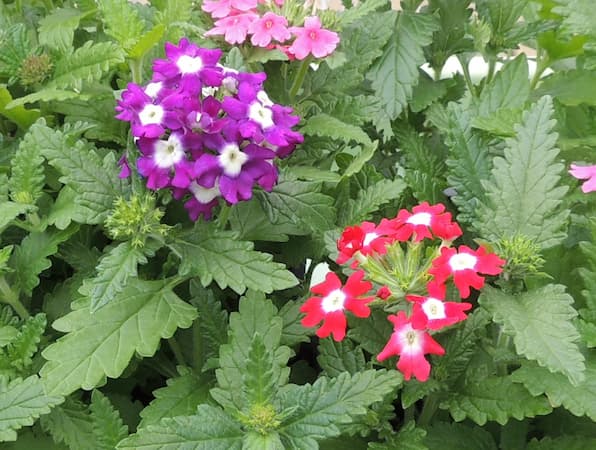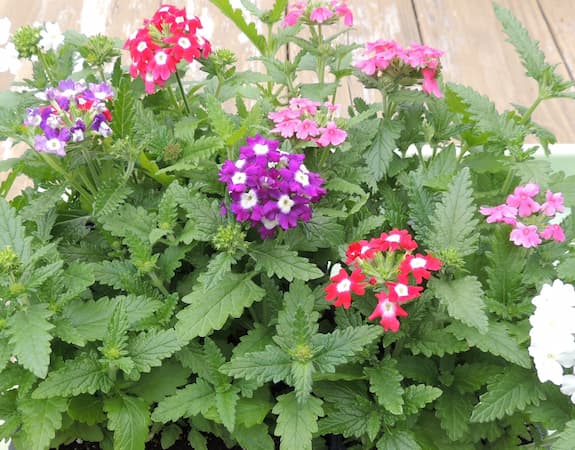How to Grow Verbena Flowers

About Growing Verbena Plants in Your Home Flower Garden
Growing Verbena flowers is a thrill. Good looking and fragrant, easy to grow annual Verbena plants are natives of Great Britain. These drought-resistant, old-fashioned flowers, sit atop fern-like foliage. Verbena flowers are large, with brilliant blooms in several colors. Some flowers have flirty little eyes. Flowers bloom from mid-summer to fall. When, in bloom, you’ll love to watch the butterflies as they fly from flower to flower. Bees and other pollinators are attracted to them, too.
Verbena looks great in flower beds, window boxes, rock gardens, and containers. You will enjoy watching them as they spill over in a hanging basket. Try growing them as a ground cover, too.
Verbena Flowers Plant Specifications
Flower Colors: Shades of cream, peach, pink, purple, pink, red, rose, violet, and white.
Flowers Bloom: Spring to Fall
Plant Height: Small, but luscious, most varieties of these bushy plants grow only eight to twelve inches tall. They spread out two feet or more. There are a handful of larger varieties of Verbena that grow three to four feet tall.
Ideal Soil pH: 5.8 – 7.2.
Plant Hardiness Zones: 7 – 11
Light Needs: Full sunlight to partial sun.
Toxic Plant? No. However, some varieties are toxic to some animals. As a result , we recommend you keep pets away from this plant.
Deer Resistant? Yes. Deer and rabbits do not normally eat this plant. However, they will if they are hungry enough.
Number of Species: 150 species.
Plant Type: Annuals and perennials.
Native To: Americas, Asia, and Europe.
Botanical Name: Verbena officinalis
Other Names: Bearded Pink, China Carnation, Sweet John, Tears of Iris
Are Verbena Plants Edible?
NO, for most varieties.
Most species of Verbena are not edible. Lemon Verbena is the only edible variety. It has a bitter taste. So, most people do not consume it.
Consumption of non-edible varieties can cause confusion, dizziness, nausea, and vomiting.
Medicinal Uses for Perennial and Annual Verbena Flowers
Despite this plant’s toxicity, it is commonly used in traditional medicine and home remedies. Here are some of the medicinal applications of Verbena plants:
- Use it to soothe a sore throat.
- It helps to reduce fevers.
- Relieve the symptoms of colds and upper respiratory ailments.
- It relieves the pain of arthritis and gout.
- Use it to ease gastric pains.
- It is a treatment for headaches and migraines.
- It is sometimes used as a treatment for mild depression.
Important Note: As a toxic plant we do not recommend using it in home remedies unless you are properly trained in the safe medicinal preparation of this plant.
Light Requirements
Verbena plants grow their best in full, direct sunlight. And, the flowers are most prolific when grown in full sun. Plant them in a location where they will receive bright sunlight for eight to ten hours or more each day.
In hotter regions, they benefit from a little partial sunlight or light shade in the afternoon to protect them from the hot sun. However, too much shade results in fewer flowers.
Annual Verbena Plant Propagation
Verbena is grown from seed, but do not germinate easily. Start Verbena seeds indoors six to eight weeks before the last frost in your area. Or, you can buy young plants at garden stores in the spring.
Note: For indoor starts, we recommend using a heated germination mat, to increase the speed of germination. And, it, results in a higher germination rate.
Final Plant Spacing: Space plants 1 1/2 to 2 feet apart and allow them to spread, filling in open areas.
Days to Germination: Seeds sprout in 14 – 28 days.

How to Grow Verbena Flower Plants
Planting and Soil Needs:
Verbenas are not a demanding plant. For optimal growth, select a growing location where they will receive bright, direct sunlight all day long. And, pick a location where these prolific self-seeders can grow for many years.
They grow well in average soils. However, the soil should drain well. Avoid planting them in an area where the soil can become soggy in wet weather. Mix a little compost into the planting site to give the plants a good, fast start. After planting, water the plants. If you are planting seeds, water lightly If you are planting seedlings, apply enough water to reach the lowest roots.
Fertilizer Needs:
Add a general-purpose fertilizer at planting, especially if the soil is poor. Then for optimal growth and plant health, apply a balanced general-purpose fertilizer once a month during the growing season.
Water Needs:
Verbenas are heat and drought-tolerant. Keep the soil moist, but not wet. They likely will not need extra water most of the year. However, make sure to water the plants during hot weather and extended droughts.
Water the plants in the morning. This allows the leaves to dry quickly and, lowers the risk of plant fungal diseases.
Other Steps:
Keep the plants wee-weeded, especially when the plants are young.
Apply a layer of mulch around the plants to create a neat and tidy appearance, and to help retain soil moisture.
Do not let the plants get too bushy. To minimize the risk of plant disease, allow for plenty of air circulation. between the leaves and stems.
Once the plants are established, they require little care and will spread out to cover the flower bed space you allotted for them.
How to Grow Verbena Plants in Flowerpots and Containers
Verbena flowers look great growing in any flowerpot or container. And, they brighten up any sunny place where you put them. And when in bloom, breathe in their fragrant smell from your patio or in a window that has a windowsill planter.
In addition to normal plant care (above), here’s how to grow Verbena flowers in containers:
- Select a sunny location on your balcony or deck.
- It is important to have a drain hole in the container to allow excess water to drain from the pot.
- Keep an eye on the moisture level. Check the plants every few days, especially in extended periods of hot, dry weather.
- Keep the soil moist to slightly dry. Allow the top of the soil to dry between watering.
- When watering the plants, thoroughly wet the soil. Excess water will drain through the hole in the bottom of the flowerpot.
- Avoid putting water on the leaves in the afternoon or evening hours.
- Nutrients in a flowerpot are limited. So, use fertilizer spikes to feed the plants. Or, apply a light solution of liquid fertilizer every two to three weeks.
How to Prune Verbena Plants
Both annual and perennial Verbena plants benefit from an active pruning regimen. It helps to keep your Verbena plants healthy and vibrant.
The stems often become leggy, and the plant loses its attractive shape. Prune the plants two times a season. Cut the plants back by a third or less. This helps to rejuvenate the plant. You will be amazed at how quickly it comes back looking better than ever.
Your pruning plan should include actively removing spent flower blooms. This encourages the plant to create new flower buds and extends the blooming period.
More on deadhead spent flower blooms.
Insects and Plant Disease
Insect and disease problems are not too common. If insect or disease problems occur, treat early with organic or chemical insect repellents and fungicides.
Also see: Plant Problems – Identify the causes and find the cures, too.
How to Overwinter Verbena Flowers
If you are growing annual Verbena flowers, simply pull up the plants after the first killing frost in the Fall. Then, toss the plants into your composter or compost pile.
Overwintering Perennial Verbena Plants Outdoors
Cut the plant back by about one-half. Apply a thick layer of mulch over the root area to protect the roots. Then, in the early spring, rake off the excess mulch. Prune back any winter-damaged growth.
For Overwintering Perennial Verbena Plants in Containers
If left outdoors in cold northern climates, the roots can freeze and die in a flowerpot. So, plan on sheltering the containers from the most brutal winters. First, cut the plant back by about one-half. Next, bring the container into a cool garage or shed. Bring the containers back onto your patio or deck in early spring after all danger of frost has passed. Cut back any growth that has died during the winter months.
Related Articles
Also, people who read this article about “How to Grow Verbena Flowers” will also like:
How to Grow Verbena Flower Plants – by Garden Hobbies
Please support our site. Shop for:
- rmmatthews100@hotmail.com
- 585-721-6528
- Rochester, NY
©1999-2024 GardenersNet.Com, All Rights Reserved

